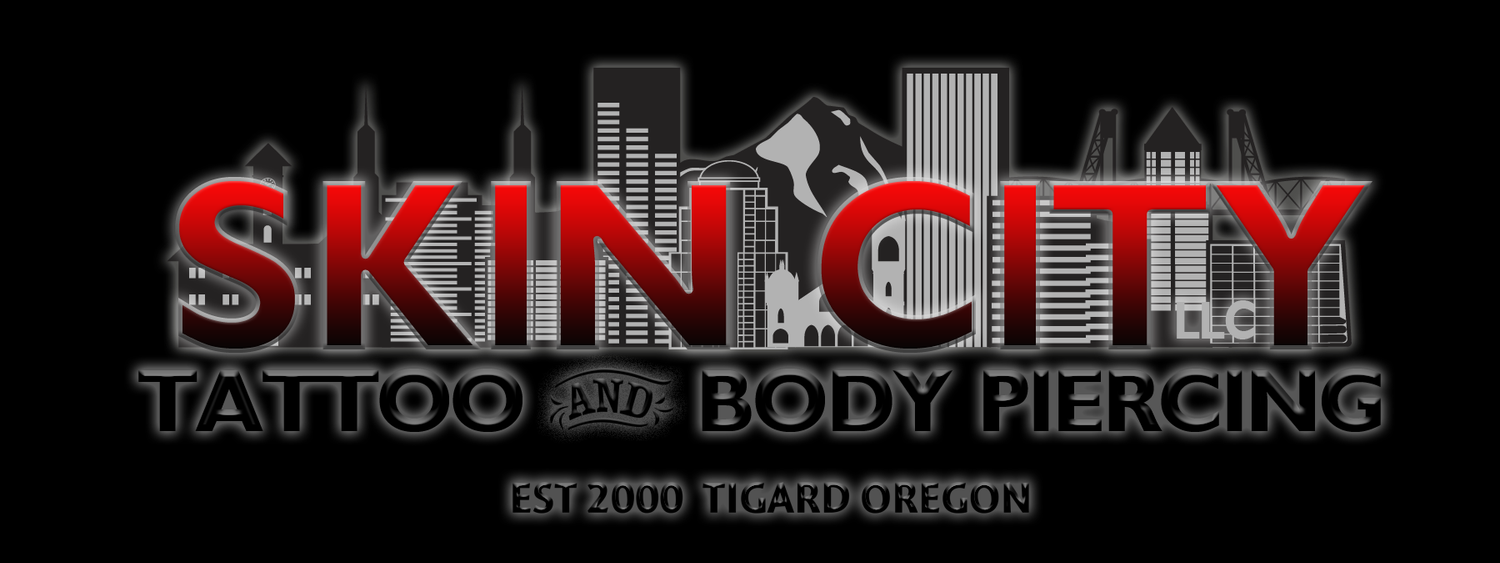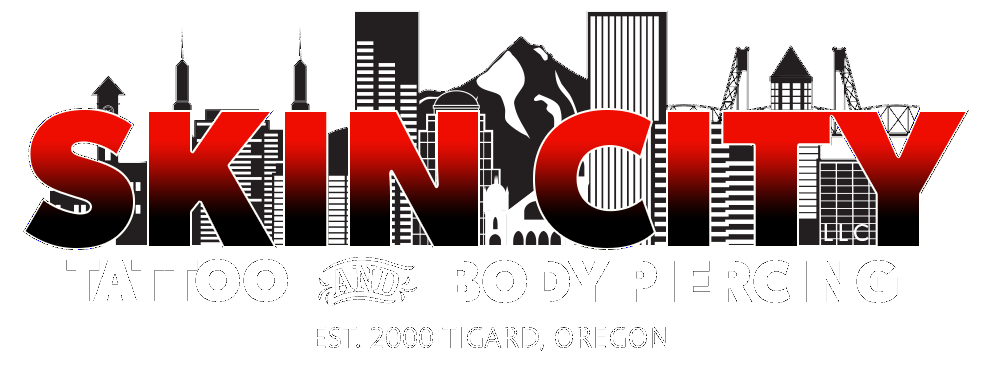
Preparing for your Piercing
And other frequently asked questions.
Preparing for your Appointment
When preparing for your appointment it is important to consider a few things, in order to have the most successful and long-term outcome.
Anatomy
Piercing placement is very anatomy dependent, even piercings as popular as ear lobe piercings may not be a safe piercing for everyone’s body. During your appointment your piercer will conduct an anatomy assessment before making the final decision to pierce.
Common piercings that are heavily anatomy dependent:
Daith, Rook, Tragus, Industrial, Navel, Nipple, Septum and Surface/Dermal Piercings. When coming in for one of these piercings we recommend having a back-up option in mind just in case.
The Procedure
It is ideal to eat a healthy portioned meal within four hours of being pierced. You don’t want to be starving or stuffed. Having stable blood sugar bolsters your immune system and helps the body deal with the fluctuation of endorphins, which are released during the piercing process.
Avoid caffeine, alcohol and aspirin. Services will be refused if you are under the influence of any mind altering substances.
A Valid Photo ID will be required for your appointment. For minor ID requirements, including age limitations visit our MINOR Policy
After Your Appointment
When scheduling your appointment, it is important to consider the healing times to avoid potential complications. Certain activities must be avoided (like swimming) during the healing process.
Frequently Asked Questions
-
Your total investment is heavily dependent on the piercing(s) you selected, jewelry you pick out, and your anatomy. We are proud to have a large collection of options to choose from that is constantly growing! However, since we are a service-based studio, and not a retail store, our inventory can vary, which makes it difficult to accurately quote you before your appointment. Even basic jewelry selection is anatomy dependent, which can only be assessed in person by a piercer.
We recommend that our clients plan to invest a minimum of $100 per single piercing with basic titanium jewelry. -
We have a $40 fee that will be applied to compensate us for the time set aside for clients who choose to not show up for their scheduled appointment start time or need to cancel within 24 hours of their scheduled appointment time. This fee is charged to the card on file.
In order to avoid this fee, we ask that you call, leave a voicemail or email us to let us know.
All appointments must arrive on time, should you arrive. All parents/guardians must arrive with their child. Minors cannot be left unattended in the shop. Should you arrive 10 minutes or later for your appointment you may be asked to reschedule, and the $40 fee may be applied. -
Yes, but restrictions do apply. Visit our Minor Policy Page for more information
-
Age restrictions do apply for all procedures. For more information regarding our age recommendations and other minor policies click here.
Anyone under 18 must be accompanied by an adult for all procedures including jewelry changes and piercing removals. -
At this time, our shop is conducting business on an appointment only basis. Available appointments can be reserved through our scheduling page. We are reserving all appointments through our online scheduling service. You can reserve your appointment here.
-
We do not use piercing guns.
We are licensed professionals who take great pride in working with needles as our weapon of choice. Piercings done with single-use hollow point needles are cleaner, less traumatic to the tissue and the client, heal better and pose a lower risk for complications.
For more information visit: -
Our tool selection varies depending on the piercer and procedure you are wanting to book for. Some of our artists pierce using free-hand techniques (use no tools) the majority of their piercings, some work on a primarily disposable basis and some require specific tools such as receiving tubes or tapers. All of our artists pierce using single-use sterilized needles.
If we need to utilize a tool, we have a multi-step cleaning protocol that follows OHA health and safety standards. These machines are serviced and checked regularly to ensure they continue to work properly. We utilize two machines in our cleaning process, an ultrasonic to remove microscopic debris; and a steam autoclave to sterilize the tools and render then re-usable. This process does not apply to needles. Needles are always disposed after a single use, according to state guidelines.
Any tattoo/piercing studio who does not utilize these items is not a safe studio to be at; and is a risk to you and your health. -
We use jewelry that meets the standards set by the Association of Professional Piercers for initial piercings; and those required by the state of Oregon.
We carry implant grade surgical steel that is ASTM F-138 compliant, implant grade titanium (Ti6Al4V ELI) that is ASTM F-136 (or ASTM F-67) compliant, Niobium, gold between 14k and 18k, and many biocompatible types of glass: Fused quartz glass, lead-free borosilicate, or lead-free soda-lime glass.
We also have certificates from all of our jewelry companies that we can provide specific information regarding the alloy mix of our metals in case there is a hyper sensitivity to nickel or other types of metal.
Jewelry bought online or in common places, like the mall or gas stations, are usually “mystery metals” made of who-knows-what from who-knows-where and are usually price hiked to imply quality. It is important to only put safe materials in your body, and to avoid plated, painted or acrylic jewelry.
Body jewelry is available in many different colors, styles and materials. We can even supply custom pieces upon request. -
We do not accept outside jewelry for an initial piercing. We provide only high grade jewelry that is compatible with the body from well known, reputable body jewelry companies. The state of Oregon also requires that we process jewelry in a specific manner based on standards set forth by the Association of Professional Piercers before insertion.
When it comes to inserting jewelry into a healed piercing, we recommend purchasing your new pieces from us, or another reputable piercer. lower quality jewelry can contain ingredients that can degrade overtime or cause irritation in even the oldest of piercings. Due to this, we cannot safely install jewelry from studios or stores who utilize other sources.
-
So long as the piercing was healed to its fullest, and it wasn’t torn or infected at the time you took it out, the piercer can use a small tool to check the site to see how far, if at all, the piercing might still be open. Sometimes it can be reopened this way and you may experience minor irritation for a few short days before the piercing is back to normal. It also gives the piercer a chance to assess the situation and suggest options further on re-opening vs. re-piercing. If a re-piercing is required, anatomy evaluation may be required to ensure the success of a re-piercing.
If your jewelry has come out and you are worried about it closing up, we recommend reserving a Jewelry Change appointment with our studio so we can insert it safely before it closes.
-
You will need to invest in jewelry that will work temporarily until you can get your regular piece back in, or a low- key piece of jewelry that can stay in without looking too obvious.
“Retainers” are usually what you will be asking for. They can come in either plastic or glass, but keep in mind plastic should not be worn long term in ANY piercing, healed or new. The body’s natural acidity can cause a breakdown in plastic that will destroy the piece if kept in too long. Ideally you would only keep plastic retainers in for as long as it takes to deal with the situation/activity until you can put your original piece back in. Glass is completely okay to wear long term and to use as an initial piece of jewelry for a piercing, in some cases. Glass is hypoallergenic and biocompatible and won’t interfere with MRI/CAT scans or surgery.
If the situation is that the jewelry is needing to be low-key, there are options for “flesh colored” pieces. For example, Neometal has tiny press-fit ends that are textured (non-shiny) in shades of brown and pink tones to emulate the illusion of a mole or a freckle. Glass and silicone can also come in shades of pinks if expanded earlobes need to be downplayed. Septum piercings can easily be flipped up into the nostril by wearing Circular Barbells (aka: horseshoe-style) or U-shaped retainers in metal or glass. Anodizing metal can also help downplay visibility by oxidizing the outer layer of the piece in different browns, yellows, or pinks. Surgical Steel does not have the ability to be colored but Titanium and Niobium are metals that can be colored by this process. Anodizing is a controlled oxidation process where metal has a reaction to being set in an acidic chemical bath while electricity is ran through at different frequencies. It does not involve paints or coating the outsides of metal, which makes it the safest option for wearing long term.

